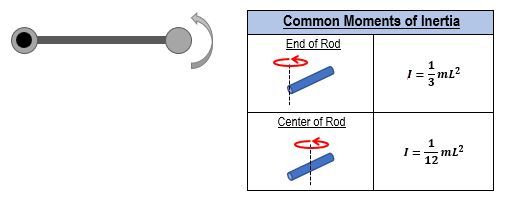Angular momentum, denoted as \( L \), is a crucial concept in rotational dynamics, particularly when analyzing the motion of point masses and rigid bodies. A point mass is considered an idealized object with no shape or volume, while a rigid body has a defined shape and size. Understanding the distinction between these two is essential for solving problems related to angular momentum.
For a point mass moving in a circular path around a central axis, the angular momentum can be expressed using the formula:
\[ L = I \omega \]
where \( I \) is the moment of inertia and \( \omega \) is the angular velocity. The moment of inertia for a point mass is calculated as:
\[ I = m r^2 \]
Here, \( m \) represents the mass of the object, and \( r \) is the distance from the axis of rotation. It is important to note that angular momentum is relative to the chosen axis, meaning that changes in the radius of rotation will affect the value of \( L \), while linear momentum, denoted as \( p \), remains constant for a given velocity.
The relationship between linear velocity \( v \) and angular velocity \( \omega \) is given by:
\[ v = r \omega \]
This relationship allows us to express angular momentum in terms of linear momentum. The linear momentum is defined as:
\[ p = mv \]
For a point mass, the angular momentum can also be expressed as:
\[ L = m v r \]
This highlights that while both linear momentum and angular momentum involve mass and velocity, they are fundamentally different quantities and will yield different numerical results unless specific conditions are met (e.g., when \( r = 1 \)).
To illustrate this, consider a 2 kg point mass rotating at a rate of 3 radians per second, maintaining a distance of 4 meters from the axis of rotation. The linear momentum can be calculated as:
\[ p = mv = 2 \times 12 = 24 \, \text{kg} \cdot \text{m/s} \]
where \( v \) is derived from \( v = r \omega = 4 \times 3 = 12 \, \text{m/s} \).
For angular momentum, substituting into the equation gives:
\[ L = m v r = 2 \times 12 \times 4 = 96 \, \text{kg} \cdot \text{m}^2/\text{s} \]
This example clearly shows that linear momentum and angular momentum are calculated differently and yield different results. The equation \( L = m v r \) can also be applied to find the angular momentum of an object in linear motion about an axis of rotation, demonstrating its versatility in various scenarios.
In summary, understanding the principles of angular momentum, including its dependence on the axis of rotation and the relationship between linear and angular quantities, is essential for solving problems in rotational dynamics.


